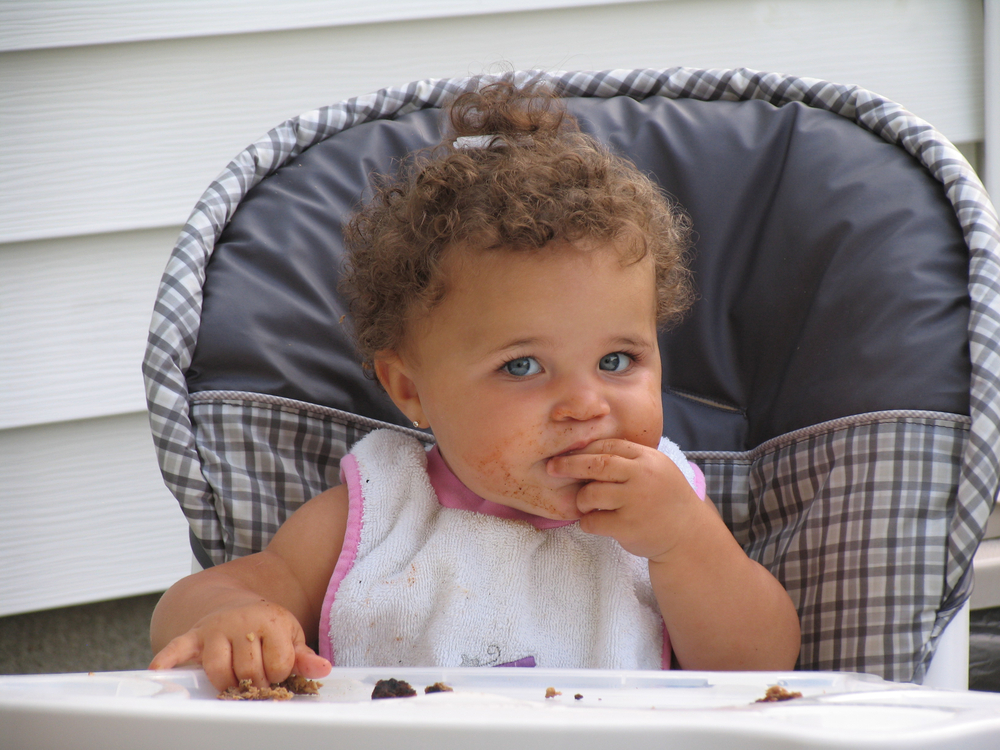It's a familiar scene: Mom or Dad delivering sweet potato purée into Baby's wide-open mouth via that special airplane spoon—complete with sound effects and announcements from the cockpit. But for the parents who practice baby-led weaning, the picture of Baby's mealtimes looks much different: The youngest member of the family sits in the high chair before a spread of finger foods, attempting to transfer the bits from tray to tongue all by themselves.
Popularized in the U.K. with the publication of Baby-Led Weaning, by Gill Rapley and Tracey Murkett, this method has long been used around the world. Now, enthusiasm for baby-led weaning is also growing in the United States. It's especially popular among young parents looking for a more natural and family-friendly way of serving solids.
Read on to learn about the benefits of this feeding method, with tips for how to start baby-led weaning yourself.
The Benefits of Baby-Led Weaning
In a nutshell, baby-led weaning means skipping spoon-feeding purees and letting babies feed themselves finger foods right from the start—at about age 6 months. The benefits can be great, says registered dietician Clancy Cash Harrison, author of Feeding Baby. For starters, it helps fine-tune motor development: "Baby-led weaning supports the development of hand-eye coordination, chewing skills, dexterity, and healthy eating habits," she says. "It also offers babies an opportunity to explore the taste, texture, aroma, and color of a variety of foods."
It's also an early—and very important—step for babies in learning self-regulation: learning to stop eating when they feel full. "Babies who self-feed cannot realistically be made to eat more than they need since they are feeding independently," says Natalia Stasenko, a pediatric dietician and co-writer of Real Baby Food. With spoon-feeding, she says, "Parents can sneak in a couple more spoonfuls even if the baby is full. Doing so frequently will teach the baby to routinely eat more than he needs and stop regulating his intake efficiently."
Though few scientific studies have been conducted on the subject, experts see potential for baby-led weaning to have a lasting effect on a child's food preferences, eating habits, and palates. Plus, you won't have to buy little jars of food or spend time blending, freezing, and defrosting homemade baby food. (#momwin!)
It's important to note, though, that baby-led weaning might not benefit every baby. "Babies with developmental delays or neurological issues should start solids more traditionally," says Dina DiMaggio, M.D., a pediatrician in New York City and coauthor of The Pediatrician's Guide to Feeding Babies & Toddlers. You'll also need to be extra vigilant about choking and food allergies.
When to Start Baby-Led Weaning
Wait until your baby is ready. Your child should be able to sit in a high chair unassisted, have good neck strength, and be able to move food to the back of their mouth with up and down jaw movements, Harrison says. "Most healthy children over 6 months of age are developmentally able to self-feed; however, strong chewing skills in some children may not be fully developed until 9 months. The baby-led weaning process will help develop those chewing skills."
Also note that "weaning" is actually a bit of a misnomer. "Breast milk or formula will continue to be a baby's biggest source of nutrition until he or she is 10 to 12 months old," says Stasenko.
The Best Baby-Led Weaning Foods
You may see photos on baby-led-weaning Facebook pages of infants chowing down on all sorts of improbable foods, from drumsticks to casseroles. But most experts recommend beginning more slowly. "Start with single-ingredient foods so you'll be able to pinpoint any food allergies," says DiMaggio.
Examples of first finger foods include banana, avocado, steamed broccoli florets with a stalk "handle," baked sliced apple without the peel, moist and shredded meats, poached and flaked salmon, pasta, omelets cut into pieces, or strips of chicken.
Substantial-size pieces—cut in long, thin strips, coin-shaped, or with a crinkle cutter—are easiest for your baby to manage. That's because very few 6- to 8-month-olds have mastered the pincer grasp (thumb and index finger), so they'll pick up foods with their whole palm. Once your baby develops this pincer grasp, around 8 to 9 months, serve food cut into small pieces, like ripe mango chunks, cooked beans, chopped steamed spinach, and pieces of pasta.
Also remember that texture is key. The food you give your novice eater should be soft and easy to smash with gentle pressure between your thumb and forefinger. For example, you should steam fruits and vegetables when beginning baby-led weaning, says Leslie Schilling and Wendy Jo Peterson, both moms, dietitians, and co–authors of Born to Eat: Whole Healthy Food From Baby's First Bite.
Once your baby has tried and tolerated several single-ingredient foods, you can begin offering mixed dishes. Make sure there are high-calorie foods and those with iron, zinc, protein, and healthy fats on the tray, advises Stasenko. "It's also a good idea to cook with little or no salt since a baby's body cannot process sodium well," she adds.

What If Your Baby Chokes?
Most babies are surprisingly adept at managing finger foods, but gagging is very common in the early days of eating. It's a normal and reflexive safety mechanism that might cause watery eyes, coughing, or sputtering. But parents should "understand that gagging is a safe reflex to get rid of food that is a little too challenging. Your baby will learn from your reaction: If you are scared, she will get scared, too," says Stasenko.
Choking, on the other hand, happens when food becomes stuck in the throat or windpipe, blocking airflow. If a baby is choking, they probably won't make sounds or effectively move air, says Schilling and Peterson.
Avoid this by staying away from choking hazards such as grapes, hot dogs, raisins, popcorn, raw vegetables, and sticky nut butters. It's also a good idea to familiarize yourself with the infant-specific Heimlich maneuver, advises Stasenko. As a precaution, always stay with your baby when they eat, and make sure they're sitting up.
To be safe, follow these rules:
Tips for Baby-Led Weaning Success
Consider a mixed approach. If spoon-feeding is most comfortable for you and Baby, there's no need to abandon it altogether before introducing finger foods. For the first month or two of self-feeding, your baby will do a lot of licking, tasting, and exploring—but not a lot of actual eating. So purees can help make meals more filling and nutritious. Plus, some children just aren't ready for finger foods at 6 months. "I am for the mixed approach, as it helps expose babies to finger foods and also minimizes the risk of nutritional gaps in the diet," says Stasenko. She recommends serving finger foods directly before or after purées, and to prepare purées with an increasingly lumpy texture to help advance your child's chewing skills.
Prepare for messes. The goal of baby-led weaning is to let your little one explore food at their own pace, so that means smashing it, smearing it, dropping it, and probably making a big old mess at nearly every meal. "Getting messy is part of the feeding process," says Harrison. "It's an essential milestone in learning to love a variety of nourishing foods." Your floor will likely see the worst of it. You can place a garbage bag or a plastic tablecloth under the high chair for easy cleanup, replace your baby's bib with an art smock, and balance messy foods with less-messy ones (like dry cereal or toast) when feeding.
Dine together. "Allow the infant to eat at the table during family meals," says Harrison. Even better: Give your baby some of the same ingredients that make up your dish.
Let your baby use safe utensils. It's key, says Harrison, to encourage your child to start participating in the delivery of food early on. "Let your child reach for the spoon and guide it to his mouth with or without your help," she says. "Make sure the child is leading the process." Avoid toothpicks or other skewers.
Rest assured your baby is getting enough nutrients. Your baby is still getting most of their nutrition from breast milk or formula, so don't worry if they don't actually swallow many solids. If they seem frustrated or unsatisfied by their meals, consider supplementing finger foods with purees until they get the hang of self-feeding.
Don't get overly heated or emotional. Eating should be treated as a natural and expected part of the day. "Don't praise, pressure, or scold about eating," advises Harrison.































